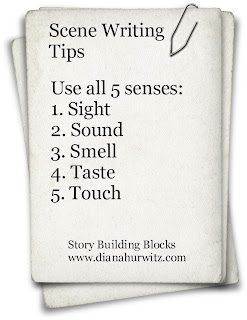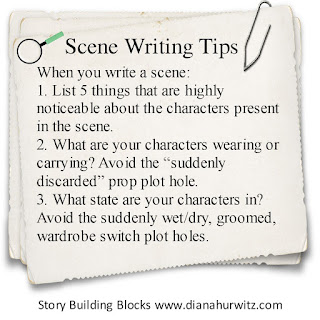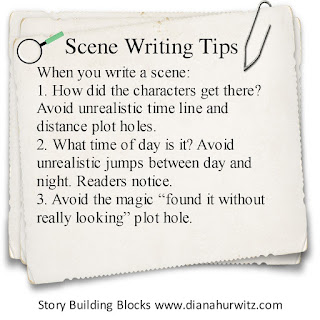Now that we have spent time honing our observation skills, let's take them for a test drive.
The following exercise is courtesy of best-selling writer Julie Hyzy, author of the highly enjoyable White House Chef Mysteries and the Manor House Mysteries available on Amazon.
At a workshop she gave at the annual Midwest Writer’s Workshop in Muncie, Indiana, we were asked to come up with five paragraphs composed of five sentences. Each paragraph should feature one sense: sight, sound, smell, taste, and touch.
In the workshop, I was riffing on an idea I had for a story about a couple, Ana and Rudi, who have been drifting apart when they go on a bus tour and end up solving a mystery.
1. Sight
We followed the ratty fleur de lis runner to room 113.
Rudi’s shoulders brushed the Hessian wallcovering.
The door fell open willingly.
Two twin-sized beds huddled together, close but not touching.
A small television was mounted to the wall, the only nod to modernity.
2. Sound
The lock squealed in protest but obeyed.
Birds ceased their chatter on the window sill, startled but not frightened.
Water drip-dropped from the tap in the bathroom.
Tired rumbled over the cobbled street below.
The ocean shushed them all.
3. Smell
The must and mold tickled my nose.
The armoire held the perfume of centuries: old roses and peat fires.
Rudi stripped and stepped into the shower, filling the room with herbal steam.
I sat on sheets smelling of bleach and waited my turn.
My clothes reeked of anxiety and sweat.
4. Taste
I filled a glass with water, wincing at the metallic tang.
I popped a stale Tic-tac.
It didn’t complete erase the acrid taste that comes from viewing a decomp.
I rooted through my sack for the peppermint mouthwash and swished.
Not enough. I searched for the squished remnants of a Reese’s cup and the comfort of chocolate and peanut butter.
5. Touch
The mattress was thinner and harder than a gym mat.
The comforter was a wisp and the pillows a mere suggestion.
The sheets were rough against my legs.
I fumbled for the remote, sticky from strangers’ hands.
I pushed the rubbery on button and waited. No service.
Then you choose what you consider the best of the five and combine them:
"We followed the ratty fleur de lis runner to room 113. The lock squealed in protest but obeyed. The armoire held the perfume of centuries: old roses and peat fires. I filled a glass with water, wincing at the metallic tang. I fumbled for the remote, sticky from strangers’ hands."
You can see the value of not always choosing the first detail that pops into your head. You can expand, tweak, and tighten it for your manuscript.
This exercise really helped me because I write a bare bone draft (dialogue and choreography) first, then feather in details, like adding a color wash to a pencil sketch. I sometimes struggle with what details to put in and which to leave out.
I hope this exercise helps you too.
In the workshop, I was riffing on an idea I had for a story about a couple, Ana and Rudi, who have been drifting apart when they go on a bus tour and end up solving a mystery.
1. Sight
We followed the ratty fleur de lis runner to room 113.
Rudi’s shoulders brushed the Hessian wallcovering.
The door fell open willingly.
Two twin-sized beds huddled together, close but not touching.
A small television was mounted to the wall, the only nod to modernity.
2. Sound
The lock squealed in protest but obeyed.
Birds ceased their chatter on the window sill, startled but not frightened.
Water drip-dropped from the tap in the bathroom.
Tired rumbled over the cobbled street below.
The ocean shushed them all.
3. Smell
The must and mold tickled my nose.
The armoire held the perfume of centuries: old roses and peat fires.
Rudi stripped and stepped into the shower, filling the room with herbal steam.
I sat on sheets smelling of bleach and waited my turn.
My clothes reeked of anxiety and sweat.
4. Taste
I filled a glass with water, wincing at the metallic tang.
I popped a stale Tic-tac.
It didn’t complete erase the acrid taste that comes from viewing a decomp.
I rooted through my sack for the peppermint mouthwash and swished.
Not enough. I searched for the squished remnants of a Reese’s cup and the comfort of chocolate and peanut butter.
5. Touch
The mattress was thinner and harder than a gym mat.
The comforter was a wisp and the pillows a mere suggestion.
The sheets were rough against my legs.
I fumbled for the remote, sticky from strangers’ hands.
I pushed the rubbery on button and waited. No service.
Then you choose what you consider the best of the five and combine them:
"We followed the ratty fleur de lis runner to room 113. The lock squealed in protest but obeyed. The armoire held the perfume of centuries: old roses and peat fires. I filled a glass with water, wincing at the metallic tang. I fumbled for the remote, sticky from strangers’ hands."
You can see the value of not always choosing the first detail that pops into your head. You can expand, tweak, and tighten it for your manuscript.
This exercise really helped me because I write a bare bone draft (dialogue and choreography) first, then feather in details, like adding a color wash to a pencil sketch. I sometimes struggle with what details to put in and which to leave out.
I hope this exercise helps you too.
For more information on scene writing visit http://www.dianahurwitz.com for free downloads and pick up a copy of Story Building Blocks: The Four Layers of Conflict available in e-book and print.
0 Comments on Description Exercises as of 4/14/2016 10:26:00 AM
Add a Comment






